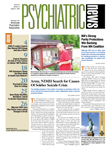Should the DSM-V include a diagnostic category for psychosis risk syndrome?
It is one of the most hotly debated issues in the development of the next version of the diagnostic manual. On the one hand are those who point to a robust prevention science that has identified risk factors highly predictive of psychosis and who say that early intervention before the first psychotic break can dramatically alter the long-term course for at-risk individuals.
On the other hand are those who point to the risk of stigmatizing adolescents—the age group that would typically be receiving a diagnosis of risk syndrome for psychosis—and who say that the putative risk behaviors are too widely distributed among the general population to reliably distinguish them from normal behavior. They also note the possibility of exploitation by the drug industry eager to open a wide new market for prescribing.
Allen Frances, M.D., has included the point in criticisms he has leveled in Psychiatric Times against the DSM-V Task Force, saying that the science of prevention is not advanced enough to warrant a new diagnostic category.
“No set of descriptive criteria can be nearly specific enough to avoid a huge false-positive problem—particularly once the drug companies sink their teeth into it,” Frances told Psychiatric News.“ Prevention is great if you have a specific test, but in our field this will almost certainly have to be a biological test, because the descriptive items are nonspecific and widely distributed in the general population. Discussing this as an addition to the appendix would have been useful. Going beyond to suggest that prodromal diagnosis is ready for prime time is a misleading overselling of our current capacity to predict the future.”
Leaders and members of the DSM-V Psychosis Work Group say the inclusion of a subsyndromal category for pre-psychosis is by no means certain. The topic was also the focus of a Web seminar conducted by Psychosis Work Group Chair William Carpenter, M.D.
“In general medicine there is a tradition of treating at-risk patients,” Carpenter told Psychiatric News. “You don't have to have cardiovascular disease to receive a statin drug, and it's legitimate for a doctor to code for a risk category. Whether we are in a position to anticipate that in psychiatry is debatable.
“We know we can identify people at risk for psychosis, and we know that if we follow them for a year or two, 20 percent to 35 percent will convert to one of the psychotic diagnoses,” Carpenter said. “There are legitimate concerns about stigmatizing and excessive prescription of drugs. But my own sense is that once a psychosis is established, there is an adverse effect on the long-term course, and so there are a lot of reasons to be interested in the data on intervention that suggest you can make the long-term course a lot better.”
Carpenter said that if included, a risk syndrome category related to psychosis risk would likely be written as a separate chapter to underscore that it is not a diagnosis of psychosis and need not be tightly linked with schizophrenia. Other sub-threshold risk categories could be added as prevention science advances.
The most vigorous response to Frances came from Thomas McGlashan, M.D., a pioneer in prevention of psychosis. He said Frances's criticisms ignored the substantial literature on the value of early intervention, belittled the demonstrated predictive capacity of proposed risk syndrome criteria, and slighted the harm that can be done to true positives by failing to receive a diagnosis of risk.
“The risk syndrome criteria we are proposing for DSM-V have already proven capable of identifying a clinical entity within a help-seeking population in which 1 out of 3 individuals develops a bona fide DSM-IV psychotic disorder within two and a half years,” he said. “This amounts to a true positive rate of 33 percent.”
McGlashan said that compares favorably with the predictive power of hypertension for stroke or of hyperlipidemia for a coronary event.
Regarding Frances's concern about the “false-positive” individual, McGlashan countered: what about the true-positive person who“ regularly gets forgotten in the surge of self-righteous indignation” about false positives?
“For the true-positive person, the consequences of not monitoring risk over time could well be an unexpected chaotic first psychotic break destructive to reputation if not to physical well-being, leading to a negative, adversarial, revolving-door relationship with the treatment system, not to mention the ultimate deficit of chronic schizophrenia. These risks, and the evidence that early detection and intervention can modify them, get ignored regularly in the exclusive focus on the false-positive 'victim' of early detection.”
Carpenter said consideration of “stigma” requires more nuance than Frances's anxiety about false positives in the general population; rather, it needs instead a careful weighing of distress and disability among a help-seeking population and of the harm or benefit associated with several possible diagnoses.
“The number of false positives in population sampling is meaningless,” he said. “It is the number of false positives in a help-seeking group experiencing disability or distress that matters. Then, the question remains: to what extent are these false positives harmed versus helped by placing them in a risk syndrome class? Some will proceed to other diagnoses [other than a psychotic disorder], some to schizotypal, and some will not proceed to a diagnostic category. In each instance, what is the good and the harm? But the debate is meaningless if one simply presumes all false positives are harmed.”
The online forum of the Psychosis Work Group on inclusion of a category for the prodrome can be accessed at<www.schizophreniaforum.org/for/live/detail.asp?liveID=68>.▪
